
views
Recognizing and Reciprocating Affection

Be available for your cat. Many dogs tend to react to any opportunity for attention by running, yelping, and slobbering in appreciation. Cats are more likely to want to dictate the times and terms of affection, although they may want some prodding from you from time to time. It's hard to show affection if you are never around, so be a present cat parent when possible. Simply sitting in the same room will present your cat with opportunities to display affection and give clues that it desires reciprocation. Talk to your cat when you're spending time together. Whether your cat can actually learn to recognize any of your words or not, the act of talking provides an opportunity for interaction that can be reciprocated in the feline's preferred manner. If your cat has to spend long stretches of time alone, play with your cat before you go out, and provide an environment where the cat can entertain himself, such as having toys available, and a high perch where he can watch what's going on outside. Then, be sure to play with your cat when you do return.
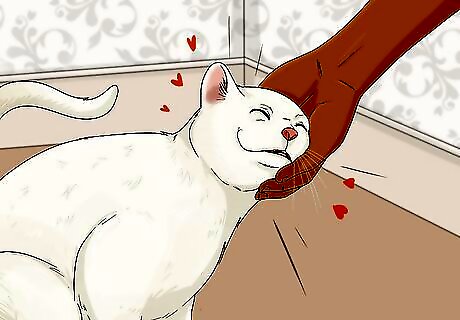
Let yourself be claimed. While most cats are content with their own company, that does not mean they prefer being solitary creatures. A cat that wants to include you in its circle is in turn seeking proof of your acceptance of this inclusion. The well-known cheek rub (or “bunting”) performed by cats — really often a full-body rub from nose to tail — is a way for them to mark you with their scent. Cats release pheromones from glands in their cheeks, and use this scent marking to in essence claim you. Simply permitting this bunting to occur is an easy way to show affection by accepting affection.

Appreciate being chosen. Cats, like people, like to shower those they love with gifts, although these gifts may be a dead mouse placed on your pillow instead of a bouquet of roses. If you're lucky, your gift might just be a favorite toy or plaything. A cat's choice to sleep on or near you is also usually a sign of affection. Cats, like any animal, are vulnerable when asleep, and need to fully trust your affection and protection to sleep so close to you. So, even if you might prefer not sharing the foot of your bed with your cat, doing so shows appreciation and affection on your part.
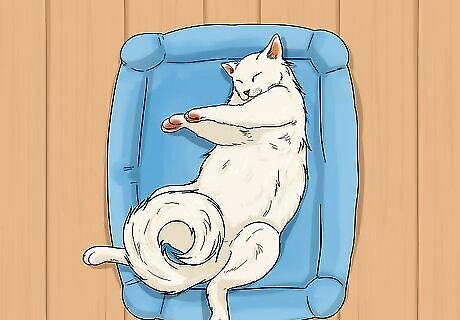
Watch for signs of trust. In addition to displaying trust by cozying up next to you, a cat can display affection-via-vulnerability by stretching out and exposing its stomach and underside to you. Be aware, however, that many cats may expose their stomachs without actually wanting you to pet them there. Watch for signs of interest in being petted, or gently stroke the cat's belly and see if you get away without being scratched and/or bitten. Here again, sometimes the best way to show affection to a cat is to let them show you affection and to accept it graciously.

Make the first move as needed. While many cats are not shy about showing affection, others seem aloof because they are waiting for you to show affection to them first — or at least for you to put yourself in a position to be properly shown affection by them. Some cats just want you to make a fuss over them first. Looming over a cat makes them nervous; it is what predators do just before they attack. Take yourself down to the cat's level. Sit or squat so they can be more or less face-to-face with you. When petting, rather than lowering your hand down from above (too much like a hawk swooping down), bring it in from the side or below, and gradually work your way to the top of the cat. Don't chase a nervous cat. Many cats will be more likely to approach you if you ignore them. When they finally do come close, let them smell you before trying to touch them. If the cat's ears are moved to the back of its head it means they dislike what you are doing to them, so come back, and try something else that they might like. Always let your cat sniff your hand, if he/she leans away don't pet them at that moment. If your kitty rubs against your hand, he/she wants to be petted.
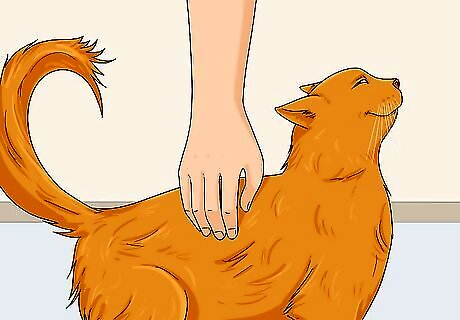
Recognize signs of affection. Some cats love being petted, others simply tolerate it, and some just plain dislike it. They best way to find out is to gently pet your cat in a “safe” spot like along the spine and gauge its reactions. Purring, for instance, is a good positive sign. Petting a cat that doesn't want or like it can cause undue stress and will not be perceived as affection. You can encourage “bunting” by holding out your index finger at about the cat's eye level, within a short distance away or even across the room. Most cats will interpret this as a sign that you want to be rubbed and marked. “Cat kisses” — slow blinks of half-closed, sleepy-looking eyes — are a typical sign of feline affection and can easily be reciprocated by you. You can also offer cat kisses yourself first and wait for a response from your cat.

Play with your cat. As with any companion, sharing quality time together and having fun is a universal sign of affection. Cats love to play; figure out what activities yours enjoys most and spend time every day playing together. Most cats enjoy chasing and catching things, so everything from toy mice to wadded up sheets of paper can make a fun game. A ping-pong ball taped to a string or a laser pointer swirling its beam along the floor (but never anywhere near the cat's eyes) can provide entertaining exercise as well. Cats love to climb and scratch, so consider a tiered scratching post, perhaps with a target or toy at the top to present a goal/challenge. Many cats like to hide in something such as a cardboard box and pounce out at a moving toy as well. Keep play sessions relatively short, and spread them out throughout the day. Don't force a cat to play or train, or play time can turn sour quickly. Cats also tend to bore easily, so mix up the games and routines often. But always be mindful of how your cat responds — no two cats are alike in their play preferences. Spend playtime with your cat, not only to prevent possible injury — such as the choking hazard presented by something as simple as a string — but also to train and create bonding time with your feline friend. Catnip is completely harmless to cats, and they enjoy it very much!
Showing Affection Through Regular Care
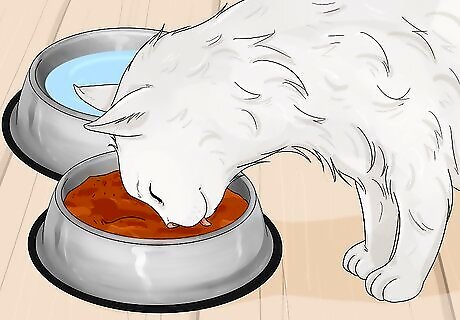
Nourish your cat properly. If, as they say, the way to a man's heart is his stomach, the same can be claimed as one way to demonstrate affection toward (and receive it from) your cat. It is best to talk to your veterinarian regarding your cat's particular nutritional needs, but generally speaking, most cats need three to four smallish meals per day, preferably of high-quality cat foods. Some human foods are all right for cats, but others are not, and it is best to check with your vet. Give treats responsibly. Take care not to give the cat too many calories so deduct part of their regular food to compensate when giving treats. Forget about the saucer of milk. Cats have difficulty digesting cow's milk, and should instead be provided with clean water at all times (that is, keep the dish full of fresh water 24/7).
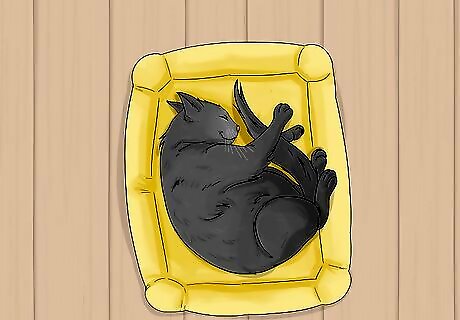
Provide your cat with personal space. Cats are often more sociable than people give them credit for, but they still like having some spots all to themselves. Even if your cat likes to sleep on or near you regularly, provide it with a soft, comfortable, semi-isolated space of its own for sleeping and lounging. Old (but clean) blankets, bedding, and pillows can do the trick. Likewise, your cat's litter box should be in a quiet yet accessible space, and should be cleaned daily. If you have more than one cat, add one extra litter box (three boxes for two cats, for instance) to help prevent any “turf wars.”
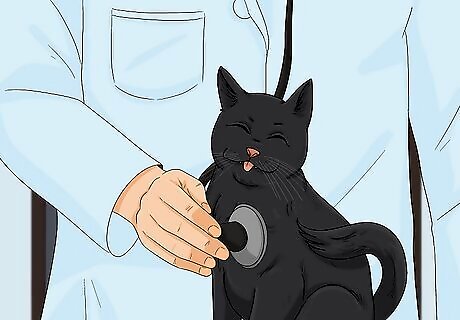
Take your cat to the veterinarian as recommended. Your cat may not see it as such at the time, but what in the long run shows more affection than doing everything you can to ensure your cat lives a happy, healthy, long life? Veterinary care recommendations for cats will vary according to factors such as age, health history, and vet preference, but one to two checkups per year is common. Starting as a kitten, make sure you keep your cat up-to-date on its vaccinations. Refer to How to Take Care of a Cat for detailed information on veterinary care and warning signs of cat illness to look out for.
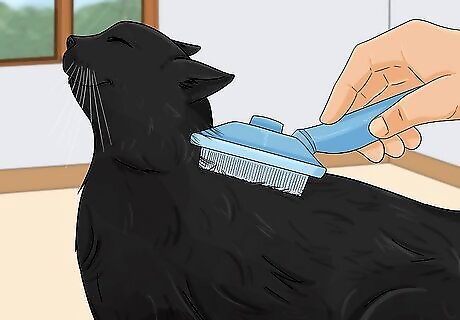
Keep your cat well-groomed. True enough, cats are quite adept at keeping themselves clean and looking good. But a little help from you, properly applied, will be beneficial and (at least sometimes) appreciated. Most cats will permit themselves to be brushed, if done gently and with the proper tool. Try a pin brush for long-haired cats and a slicker brush for short-hairs. Brush as needed to keep matting of fur to a minimum. There are also specialized brushes and tools for more sensitive areas such as around the eyes. Brushing also provides an excellent opportunity to check for fleas and ticks. While less appreciated, brushing your cat's teeth and/or bringing it to the vet's office for dental cleanings is good practice as well. How to Take Care of a Cat has information on feline dental care as well.

















Comments
0 comment